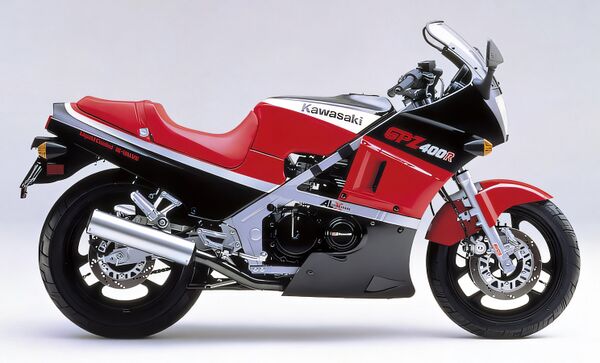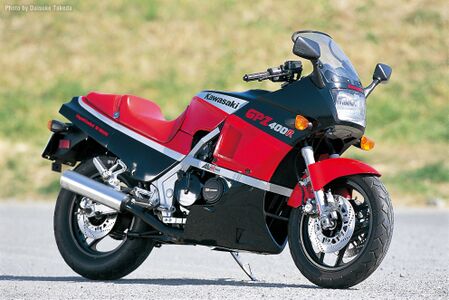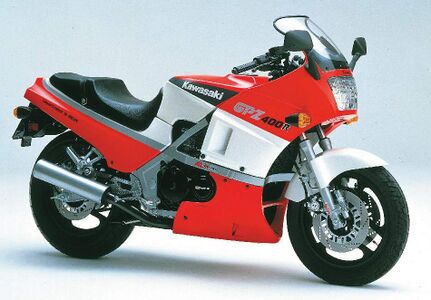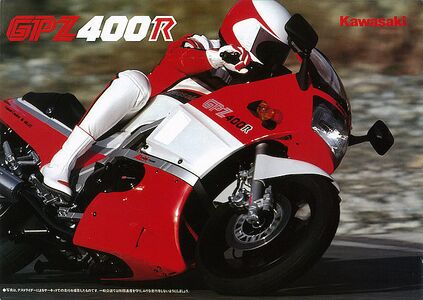Difference between revisions of "Kawasaki GPZ400"
m |
m |
||
| (8 intermediate revisions by the same user not shown) | |||
| Line 1: | Line 1: | ||
| − | {{DISPLAYTITLE:Kawasaki GPZ 400 (GPZ400R)}} | + | {{DISPLAYTITLE: Kawasaki GPZ 400 (GPZ400R)}} |
| − | |||
{{#seo: | {{#seo: | ||
| − | |keywords= | + | |keywords={{PAGENAME}}, review, specs, owners manual, service manual, guide |
| + | |og:image=https://en.enduro.team/images/f/fc/Gpz400r_mod1.jpg | ||
}} | }} | ||
__notoc__ | __notoc__ | ||
| − | + | [[file: Gpz400r mod1.jpg | 600px | center | Kawasaki GPZ400R (1985-1988)]] | |
| − | + | ''' Kawasaki GPZ 400R ''' sports bike model appeared in 1985 as a domestic Japanese version of the [[Kawasaki_GPZ600 | Kawasaki GPZ 600R (Ninja 600R)]]. Unlike the export prototype, the GPZ400R received an aluminum frame from the outset, called the Al-X Cross Frame. The export version was equipped with this frame only in the modification [[Kawasaki_GPZ600 | Kawasaki Ninja 600RX]], offered only in 1987 for the American market. | |
| − | + | {{Ads_top}} | |
| − | |||
| − | |||
| − | |||
| − | + | ''' Lineup:''': | |
| + | * [[Kawasaki_GPZ400 | Kawasaki GPZ 400]] | ||
| + | * [[Kawasaki_GPZ500 | Kawasaki GPZ 500]] | ||
| + | * [[Kawasaki_GPZ600 | Kawasaki GPZ 600]] | ||
| + | * [[Kawasaki_GPZ750_Turbo | Kawasaki GPZ 750 Turbo]] | ||
| + | * [[Kawasaki_GPZ900 | Kawasaki GPZ 900]] | ||
| + | * [[Kawasaki_GPZ1100 | Kawasaki GPZ 1100]] | ||
| − | + | At the time of its release, the Kawasaki GPZ 400 R model was in great demand - in the first year it sold 18,200 motorcycles. This success was due to the then motorcycle "boom" and the rapid fashion for replica sports motorcycles. By the way, the export version [[Kawasaki_GPZ600 | Kawasaki GPZ 600R (Ninja 600R)]] was distinguished by record power characteristics and also gained popularity in foreign markets. | |
| − | + | In 1987, the company released the successor to the GPZ400R model, which became [[Kawasaki_GPX400 | GPX400R]] (by analogy with the export version - [[Kawasaki_GPX600 | Kawasaki GPX600R]]), however, the GPZ 400 existed on the market until 1989. | |
| − | + | By 1990, the GPZ400 and [[Kawasaki_GPX400 | GPX400]] were leaving the market, giving way to a new model - [[Kawasaki_ZZR400 | Kawasaki ZZ-R400]]. | |
| − | + | The main feature of the Kawasaki GPZ400R is a liquid-cooled, in-line 4-cylinder 398 cc engine producing 59 hp. power and 35 Nm of torque. The motor is high-speed, the maximum performance is 10,000-12,000 rpm. The maximum speed is 205 km / h. | |
| − | + | Other features of the model include an aluminum tubular frame, front suspension with anti-sip function, narrow wheels 16 ', disc 1-piston brakes (in 1989 - 2-piston), 6-speed gearbox, fuel tank of 18 liters and 176 kg dry matter (1989 version - 181 kg). | |
| − | |||
| − | |||
| − | |||
| − | |||
| − | |||
| − | |||
| − | == == | + | == Photos == |
| + | <gallery mode="packed" heights=200px> | ||
| + | File:1985 gpz400r 02.jpg| | ||
| + | File:Gpz-400r 1985 1.jpg| | ||
| + | File:Maingpz400r.jpg| | ||
| + | </gallery> | ||
| + | {{Ads_feed}} | ||
{{Ads_post}} | {{Ads_post}} | ||
| − | == | + | == Specifications == |
| − | + | Specifications Kawasaki GPZ400R: | |
| − | {| class="wikitable" | + | {| class = "wikitable" |
| − | ! scope="row"| | + | ! scope = "row" | Model |
| − | |Kawasaki GPZ400R | + | | Kawasaki GPZ400R |
|- | |- | ||
| − | ! scope="row"| | + | ! scope = "row" | Motorcycle type |
| − | | | + | | sports |
|- | |- | ||
| − | ! scope="row"| | + | ! scope = "row" | Release year |
| − | |1985-1989 | + | | 1985-1989 |
|- | |- | ||
| − | ! scope="row"| | + | ! scope = "row" | Frame |
| − | | | + | | aluminum tubular - Al-X Cross Frame |
|- | |- | ||
| − | ! scope="row"| | + | ! scope = "row" | Engine type |
| − | |4- | + | | 4-cylinder, 4-stroke, in-line |
|- | |- | ||
| − | ! scope="row"| | + | ! scope = "row" | Working volume |
| − | |398 | + | | 398 cm³ |
|- | |- | ||
| − | ! scope="row"| | + | ! scope = "row" | Bore / Stroke |
| − | |56 | + | | 56.0 x 40.4 mm |
|- | |- | ||
| − | ! scope="row"| | + | ! scope = "row" | Compression ratio |
| − | |11.0:1 | + | | 11.0: 1 - ZX400D1-D3 (A) |
| − | 11.4:1 | + | 11.4: 1 - ZX400D4 (A) |
|- | |- | ||
| − | ! scope="row"| | + | ! scope = "row" | Cooling |
| − | | | + | | liquid |
|- | |- | ||
| − | ! scope="row"| | + | ! scope = "row" | Number of valves per cylinder |
| − | |DOHC, 4 | + | | DOHC, 4 valves per cylinder |
|- | |- | ||
| − | ! scope="row"| | + | ! scope = "row" | Fuel supply system |
| − | | | + | | Carburetor, 4x Keihin CVK30 |
|- | |- | ||
| − | ! scope="row"| | + | ! scope = "row" | Ignition type |
| − | |CDI | + | | CDI - ZX400D1-D3 (A) |
| − | + | Digital Transistor - ZX400D4 (A) | |
|- | |- | ||
| − | ! scope="row"| | + | ! scope = "row" | Maximum power |
| − | |59 | + | | 59.0 h.p. (43.4 kW) at 12000 rpm |
|- | |- | ||
| − | ! scope="row"| | + | ! scope = "row" | Maximum torque |
| − | |35 | + | | 35.0 Nm (3.6 kg * m) at 10,500 rpm |
|- | |- | ||
| − | ! scope="row"| | + | ! scope = "row" | Gearbox |
| − | |6- | + | | 6-speed |
|- | |- | ||
| − | ! scope="row"| | + | ! scope = "row" | Drive type |
| − | | | + | | chain |
|- | |- | ||
| − | ! scope="row"| | + | ! scope = "row" | Front tire size |
| − | |100/90-16 54H | + | | 100 / 90-16 54H |
|- | |- | ||
| − | ! scope="row"| | + | ! scope = "row" | Rear tire size |
| − | |130/90-16 67H | + | | 130 / 90-16 67H |
|- | |- | ||
| − | ! scope="row"| | + | ! scope = "row" | Front brakes |
| − | |2 | + | | 2 discs, 242mm bore, 1-piston caliper - ZX400D1-D3 (A) |
| − | 2 | + | 2 discs, 2-piston calipers - ZX400D4 (A) |
|- | |- | ||
| − | ! scope="row"| | + | ! scope = "row" | Rear brakes |
| − | |1 | + | | 1 disc, 216 mm bore, 1-piston caliper - ZX400D1-D3 (A) |
| − | 1 | + | 1 disc, 2-piston caliper - ZX400D4 (A) |
|- | |- | ||
| − | ! scope="row"| | + | ! scope = "row" | Front suspension |
| − | | | + | | AVDS Anti-Spike Pneumatic Fork - ZX400D1-D3 (A) |
| − | + | ESCS Anti-Spike Pneumatic Fork - ZX400D4 (A) | |
|- | |- | ||
| − | ! scope="row"| | + | ! scope = "row" | Rear suspension |
| − | | | + | | linkage Uni-Trak with pneumatic monoshock |
|- | |- | ||
| − | ! scope="row"| | + | ! scope = "row" | Motorcycle length |
| − | |2095 | + | | 2095 mm |
|- | |- | ||
| − | ! scope="row"| | + | ! scope = "row" | Motorcycle width |
| − | |675 | + | | 675 mm |
|- | |- | ||
| − | ! scope="row"| | + | ! scope = "row" | Motorcycle height |
| − | |1180 | + | | 1180 mm |
|- | |- | ||
| − | ! scope="row"| | + | ! scope = "row" | Wheelbase |
| − | |1430 | + | | 1430 mm |
|- | |- | ||
| − | ! scope="row"| | + | ! scope = "row" | Saddle height |
| − | |770 | + | | 770 mm |
|- | |- | ||
| − | ! scope="row"| | + | ! scope = "row" | Minimum ground clearance |
| − | |135 | + | | 135 mm |
|- | |- | ||
| − | ! scope="row"| | + | ! scope = "row" | Acceleration to 100 km / h |
| − | |4 | + | | 4.5 sec |
|- | |- | ||
| − | ! scope="row"| | + | ! scope = "row" | Maximum speed |
| − | |205 | + | | 205 km / h |
|- | |- | ||
| − | ! scope="row"| | + | ! scope = "row" | Fuel tank capacity |
| − | |18 | + | | 18.0 l |
|- | |- | ||
| − | ! scope="row"| | + | ! scope = "row" | Motorcycle weight (dry) |
| − | |176 | + | | 176 kg - ZX400D1-D3 (A) |
| − | 181 | + | 181 kg - ZX400D4 (A) |
|- | |- | ||
|} | |} | ||
| − | == | + | == Fuel consumption == |
| − | + | The minimum fuel consumption for the Kawasaki GPZ 400 can reach 4-5 liters per 100 kilometers, the maximum is 10-12 liters. The exact value depends on the riding style and the condition of the motorcycle. | |
| − | |||
| − | |||
| − | |||
| − | |||
| − | |||
| − | |||
| − | == | + | == Documentation == |
| − | * [https://drive.google.com/file/d/0B28GkOK3QDM-NFk3aEFDSl9vUGs/view Kawasaki GPZ600R (Ninja 600R, Ninja 600RX | + | [[Category:Motorcycles]] |
| + | * [https://drive.google.com/file/d/0B28GkOK3QDM-NFk3aEFDSl9vUGs/view Kawasaki GPZ600R (Ninja 600R, Ninja 600RX)] | ||
== == | == == | ||
{{Ads_recomended}} | {{Ads_recomended}} | ||
Latest revision as of 13:47, 28 June 2023
Kawasaki GPZ 400R sports bike model appeared in 1985 as a domestic Japanese version of the Kawasaki GPZ 600R (Ninja 600R). Unlike the export prototype, the GPZ400R received an aluminum frame from the outset, called the Al-X Cross Frame. The export version was equipped with this frame only in the modification Kawasaki Ninja 600RX, offered only in 1987 for the American market.
Lineup::
- Kawasaki GPZ 400
- Kawasaki GPZ 500
- Kawasaki GPZ 600
- Kawasaki GPZ 750 Turbo
- Kawasaki GPZ 900
- Kawasaki GPZ 1100
At the time of its release, the Kawasaki GPZ 400 R model was in great demand - in the first year it sold 18,200 motorcycles. This success was due to the then motorcycle "boom" and the rapid fashion for replica sports motorcycles. By the way, the export version Kawasaki GPZ 600R (Ninja 600R) was distinguished by record power characteristics and also gained popularity in foreign markets.
In 1987, the company released the successor to the GPZ400R model, which became GPX400R (by analogy with the export version - Kawasaki GPX600R), however, the GPZ 400 existed on the market until 1989.
By 1990, the GPZ400 and GPX400 were leaving the market, giving way to a new model - Kawasaki ZZ-R400.
The main feature of the Kawasaki GPZ400R is a liquid-cooled, in-line 4-cylinder 398 cc engine producing 59 hp. power and 35 Nm of torque. The motor is high-speed, the maximum performance is 10,000-12,000 rpm. The maximum speed is 205 km / h.
Other features of the model include an aluminum tubular frame, front suspension with anti-sip function, narrow wheels 16 ', disc 1-piston brakes (in 1989 - 2-piston), 6-speed gearbox, fuel tank of 18 liters and 176 kg dry matter (1989 version - 181 kg).
Photos
Specifications
Specifications Kawasaki GPZ400R:
| Model | Kawasaki GPZ400R |
|---|---|
| Motorcycle type | sports |
| Release year | 1985-1989 |
| Frame | aluminum tubular - Al-X Cross Frame |
| Engine type | 4-cylinder, 4-stroke, in-line |
| Working volume | 398 cm³ |
| Bore / Stroke | 56.0 x 40.4 mm |
| Compression ratio | 11.0: 1 - ZX400D1-D3 (A)
11.4: 1 - ZX400D4 (A) |
| Cooling | liquid |
| Number of valves per cylinder | DOHC, 4 valves per cylinder |
| Fuel supply system | Carburetor, 4x Keihin CVK30 |
| Ignition type | CDI - ZX400D1-D3 (A)
Digital Transistor - ZX400D4 (A) |
| Maximum power | 59.0 h.p. (43.4 kW) at 12000 rpm |
| Maximum torque | 35.0 Nm (3.6 kg * m) at 10,500 rpm |
| Gearbox | 6-speed |
| Drive type | chain |
| Front tire size | 100 / 90-16 54H |
| Rear tire size | 130 / 90-16 67H |
| Front brakes | 2 discs, 242mm bore, 1-piston caliper - ZX400D1-D3 (A)
2 discs, 2-piston calipers - ZX400D4 (A) |
| Rear brakes | 1 disc, 216 mm bore, 1-piston caliper - ZX400D1-D3 (A)
1 disc, 2-piston caliper - ZX400D4 (A) |
| Front suspension | AVDS Anti-Spike Pneumatic Fork - ZX400D1-D3 (A)
ESCS Anti-Spike Pneumatic Fork - ZX400D4 (A) |
| Rear suspension | linkage Uni-Trak with pneumatic monoshock |
| Motorcycle length | 2095 mm |
| Motorcycle width | 675 mm |
| Motorcycle height | 1180 mm |
| Wheelbase | 1430 mm |
| Saddle height | 770 mm |
| Minimum ground clearance | 135 mm |
| Acceleration to 100 km / h | 4.5 sec |
| Maximum speed | 205 km / h |
| Fuel tank capacity | 18.0 l |
| Motorcycle weight (dry) | 176 kg - ZX400D1-D3 (A)
181 kg - ZX400D4 (A) |
Fuel consumption
The minimum fuel consumption for the Kawasaki GPZ 400 can reach 4-5 liters per 100 kilometers, the maximum is 10-12 liters. The exact value depends on the riding style and the condition of the motorcycle.
Documentation



